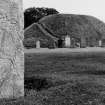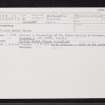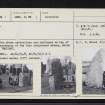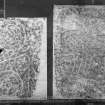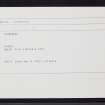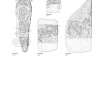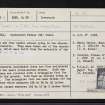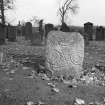Inverurie Churchyard, Symbol Stones
Cross Incised Stone(S) (Pictish), Pictish Symbol Stone(S) (Pictish)
Site Name Inverurie Churchyard, Symbol Stones
Classification Cross Incised Stone(S) (Pictish), Pictish Symbol Stone(S) (Pictish)
Alternative Name(s) Old Inverurie Churchyard; Inverurie Cemetery; Inverurie Kirkyard; Inverurie, Old Parish Church
Canmore ID 18872
Site Number NJ72SE 11
NGR NJ 78043 20611
NGR Description Centred NJ 78043 20611
Datum OSGB36 - NGR
Permalink http://canmore.org.uk/site/18872
- Council Aberdeenshire
- Parish Inverurie
- Former Region Grampian
- Former District Gordon
- Former County Aberdeenshire
Inverurie 1 Aberdeenshire, Pictish symbol stone fragment
Measurements: H 1.67m, W 0.48m, D 0.23m
Stone type: red granite
Place of discovery: NJ 6099 3025
Present location: Inverurie churchyard.
Evidence for discovery: all four symbol stones were built into the walls of the medieval church, which was demolished in 1775. They were then built into the churchyard wall, whence they were removed and set up in a line in the churchyard in the nineteenth century.
Present condition: broken and damaged.
Description
This slab is incised with parts of four Pictish symbols, one above the other: from the top, a crescent and V-rod, a circular disc and rectangle (‘mirror-case’), a serpent with a straight rod, and a double disc and Z-rod
Date: seventh century.
References: ECMS pt 3, 168-9; RCAHMS 2007, 123; Fraser 2008, no 26.1
Desk-based nformation compiled by A Ritchie 2017
Inverurie 2, Aberdeenshire, Pictish symbol stone fragment
Measurements: H 0.75m, W 0.62m, D 0.28m
Stone type: red granite
Place of discovery: NJ 6099 3025
Present location: Inverurie churchyard.
Evidence for discovery: all four symbol stones were built into the walls of the medieval church, which was demolished in 1775. They were then built into the churchyard wall, whence they were removed and set up in a line in the churchyard in the nineteenth century.
Present condition: trimmed.
Description
Part only of a symbol stone, this fragment is incised with two symbols: the disc and rectangle, and the arch, both with internal decoration.
Date: seventh century.
References: ECMS 169; RCAHMS 2007, 123; Fraser 2008, no 26.2.
Desk-based information compiled by A Ritchie 2017
Inverurie 3, Aberdeenshire, Pictish symbol stone fragment
Measurements: H 0.75m, W 0.62m, D 0.28m
Stone type: pink granite
Place of discovery: NJ 6099 3025
Present location: Inverurie churchyard.
Evidence for discovery: all four symbol stones were built into the walls of the medieval church, which was demolished in 1775. They were then built into the churchyard wall, whence they were removed and set up in a line in the churchyard in the nineteenth century.
Present condition: the top of the slab is missing.
Description
This is part of a symbol stone, incised with a large double disc and Z-rod, and above there is an arc of another symbol.
Date: seventh century.
References: ECMS pt 3, 169-70; RCAHMS 2007, 123; Fraser 2008, no 26.3.
Desk-based information compiled by A Ritchie 2017
Inverurie 4, Aberdeenshire, Pictish symbol stone fragment
Measurements: H 1.25m, W 0.82m, D 0.31m
Stone type: pink granite
Place of discovery: NJ 6099 3025
Present location: Inverurie churchyard.
Evidence for discovery: all four symbol stones were built into the walls of the medieval church, which was demolished in 1775. They were then built into the churchyard wall, whence they were removed and set up in a line in the churchyard in the nineteenth century.
Present condition: some weathering.
Description
This slab is incised with a trotting horse, facing right, with scroll joints and a long tail. The head has a pointed ear, circular eye and five hairs representing the mane.
Date: seventh century.
References: ECMS pt 3, 170; RCAHMS 2007, 123; Fraser 2008, no 26.4.
Desk-based information compiled by A Ritchie 2017
NJ72SE 11.00 centred 78043 20611
(NJ 7800 2064) Sculptured Stones (NR) found.
OS 6" map, Aberdeenshire, 2nd ed., (1928)
NJ72SE 11.01 NJ 7802 2062 Pictish Symbol Stone (Inverurie no. 1)
NJ72SE 11.02 NJ 7802 2062 Pictish Symbol Stone (Inverurie no. 2)
NJ72SE 11.03 NJ 7802 2062 Pictish Symbol Stone (Inverurie no. 3)
NJ72SE 11.04 NJ 7802 2062 Pictish Symbol Stone (Inverurie no. 4)
NJ72SE 11.05 NJ 7802 2062 Stone: Cross-incised
NJ72SE 11.06 NJ 7802 2062 Stone: Cross-incised
For Bass of Inverurie (NJ 7809 2059), Old Inverurie Churchyard (NJ 7800 2064) and Inverurie Cemetery (centred NJ 7815 2055), see NJ72SE 13, NJ72SE 15, NJ72SE 138 respectively.
There are four symbol stones lying in the church-yard at Inverurie. They were taken out of the church-yard walls, which were built from the materials of the old church (NJ72SE 15). They should be placed under cover to 'prevent their further disintegartion by the weather'. (For descriptions, see under entries for individual stones).
J R Allen and J Anderson 1903; J Stuart 1856.
In Inverurie churchyard there are four sculptured stones and two small cross-marked stones. Both the latter stones are circular with a triangular foot for fixing into the ground; both bear an incised cross on each face. The triangular foot has been broken off the smaller stone which measures 10 1/2 by 9 1/2 by 3 1/2 inches thick; the larger measures 16 1/2 by 12 by 5 inches thick.
J Ritchie 1911.
In 2018, Scheduled Monument Consent approved relocation of SM74 (four symbol stones) to within the grounds of SM99 (Bass and Little Bass Motte) and their housing within a glass case display.
The four Class I Pictish symbols stones were previously located 100m west northwest of their present location and are now in a glass display case on The Bass and Little Bass, motte-and-bailey castle (Scheduled Monument SM99). This is located within Inverurie Cemetery.
The stones are believed to have been previously built into the walls of the old parish church, which stood in the northwest corner of the adjacent cemetery. The kirk went out of use in 1775, its walls were used as a source to construct or repair the dykes of the kirkyard in the early 19th century. Three of the symbol stones were later removed from the dykes and while another was rescued when the walls were being constructed. The four symbol stones are now in a glass display case, known as and arranged (from left to right) as; Inverurie numbers 1, 2, 3 and 4.
Reference (1997)
Four Class I symbol stones.
Inverurie 1 : two groups (a) crescent and V-rod over a mirror-case (b) double-disc and Z-rod above a serpent and Z-rod.
Inverurie 2 : east facing fragment showing a mirror.
Inverurie 3 : east facing fragment showing a double-disc and Z-rod below part of a disc.
Inverurie 4 : west facing showing a horse symbol.
A Mack 1997.
Field Visit (14 August 2000)
Seven stones stand or lie on the line of a row of birch and sycamore trees between the area of the old churchyard in Inverurie cemetery and the Bass (NJ72SE 13). Four are Pictish symbol stones, one is an early 17th-century headstone commemorating Walter Innes of Ardtannes, and two are simply roughly shaped slabs, one of whinstone, the other of pink granite. These last probably served funerary function, the massive form and unshaped nature of the granite slab suggesting that it may have been used as a mortsafe to deter the activities of 19th century body-snatchers.
Stuart relates that the symbol stones 'seem to have been built into the foundations of the old church, the walls of which were pulled down to afford materials for building the churchyard dykes in the early part of the present century. Numbers 2, 3 and 4 were recently observed in these dykes, and Number 1, while in the course of being broken up by the masons, who were building the dykes, was rescued by Mr Donald of Urybank, and has lain in the churchyard since that time'.
Visited by RCAHMS (IF), 14 August 2000.
J Stuart 1856.














